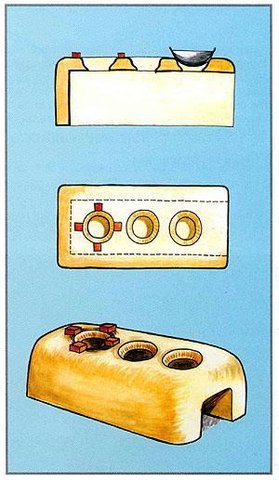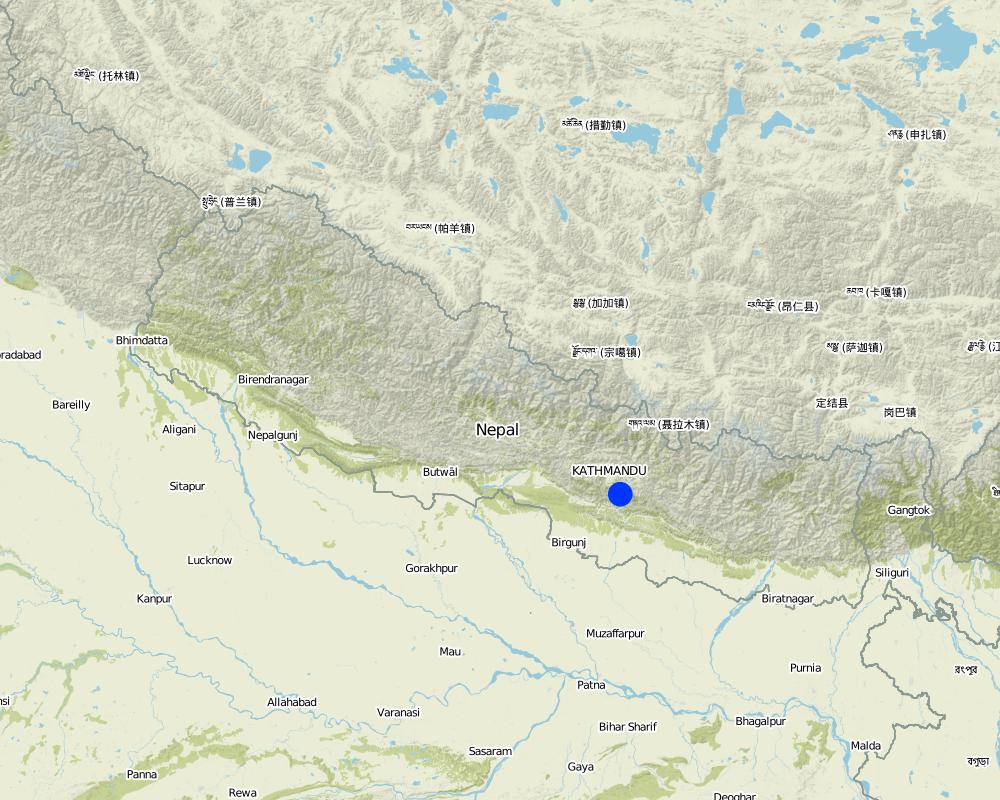Khuwa Production and Marketing in Chyamrangbesi [尼泊尔]
- 创建:
- 更新:
- 编制者: Sabita Aryal
- 编辑者: –
- 审查者: Fabian Ottiger
Khuwa Utpadan Tatha Bazaar
approaches_2482 - 尼泊尔
查看章节
全部展开 全部收起1. 一般信息
1.2 参与方法评估和文件编制的资源人员和机构的联系方式
SLM专业人员:
Ghimire Shomnath
尼泊尔
有助于对方法进行记录/评估的机构名称(如相关)
Kathmandu University (KU) - 尼泊尔1.3 关于使用通过WOCAT记录的数据的条件
(现场)数据是什么时候汇编的?:
17/01/2014
编制者和关键资源人员接受有关使用通过WOCAT记录数据的条件。:
是
1.4 SLM技术问卷的参考

Khuwa making by the use of Improved stove [尼泊尔]
The technology used is improved stove. An improved stove is a device that is designed to consume less fuel and save cooking time,convenient in cooking process and creates smokeless environment or reduction in volume of smoke against the traditional stove.
- 编制者: Sabita Aryal
2. SLM方法的描述
2.1 该方法的简要说明
This SLM Approach deals with the making of Khuwa (dairy product base), using traditional as well as improved methods and further its supply and marketing.
2.2 该方法的详细说明
该方法的详细说明:
Aims / objectives: This approach's goal is to preserve traditional khuwa production methods, while also applying new and rather sustainable technologies on the current process. Further, the local khuwa production creates employment - at the factory itself, as well as during supply and distribution processes.
Methods: This focusses mainly on the methods applied during khuwa production:
1. Milk is collected from local farmers.
2. Milk is boiled for approximately 30mins on improved stoves, using locally collected firewood.
3. Boiled is continued until milk's volume has reduced to half.
4. After around 1 hour of simmering milk has turned into a thick paste, which is known as khuwa.
5. Paste needs to be cooled.
Stages of implementation: The Khuwa Utpadan factory was founded in 2050 B.S. by locals, whose ancestors had already been involved in Khuwa production.
Firstly necessary utensils and materials were purchased. Later improved cooking stoves were installed to reduce the smoke formation and amount of required fire wood.
Role of stakeholders: 1. Providing employment opportunities to local villagers .
2. Buying milk from locals, creating a source of income for them.
3. Maintaining a regular flow of Khuwa production to purchasers in surrounding cities, including Kathmandu.
4. Preserving traditional Khuwa production methods among the local community.
Other important information: On the one hand, khuwa production has helped to create employment opportunities and to make use of locally produced milk, on the other hand stakeholders have been facing problems in supplying khuwa by paying more money .
2.5 采用该方法的国家/地区/地点
国家:
尼泊尔
区域/州/省:
Nepal
有关地点的进一步说明:
Kavre/Palanchowk
Map
×2.6 该方法的开始和终止日期
注明开始年份:
2050
2.7 方法的类型
- 传统/本土
2.8 该方法的主要目的/目标
The Approach focused mainly on SLM with other activities (Improving efficiency of production, ways of supply and marketing strategies)
The main aim of the Approach is to establish and maintain a Khuwa production factory, where traditional as well as modern technologies are being applied. That way employment is created for locals, locally produced milk is utilized and the overall economic situation of the region is improved.
The SLM Approach addressed the following problems: Firstly, consistent maintaining of production rates can be difficult, due to unreliable supply of firewood (shortages, weather etc.).
Secondly, for employees the constant influence of smoke can lead to several irritations, although the instalment of impoved stoves has already led to an improvement of the working conditions.
2.9 推动或妨碍实施本办法所适用的技术的条件
财务资源和服务的可用性/可得性
- 阻碍
Insufficient funds to make larger investments.
Treatment through the SLM Approach: Loan was granted by Chakresor baehat, as well as an government organization.
法律框架(土地使用权、土地和水使用权)
- 启动
The existing land ownership, land use rights / water rights greatly helped the approach implementation: Since this is an undertaking established and implemented by locals, already existing land ownership has helped to provide base for the factory, without the involvement of external persons.
了解SLM,获得技术支持
- 阻碍
Lack of technical knowledge has been creating lots of difficulties.
Treatment through the SLM Approach: It is advise to provide training by a professional technician.
工作量、人力资源可用性
- 阻碍
Lack of new personnel to share workload
Treatment through the SLM Approach: It is advised to train new staff.
3. 相关利益相关者的参与和角色
3.1 该方法涉及的利益相关者及其职责
- 当地土地使用者/当地社区
Mr. Shomnath Ghimire. Local milk suppliers, locals with experience in khuwa making
Construction of stoves and other utensils, manpower required for khuwa production. Women were rather involved in several housework related activities, while men were responsible for external work, such us construction and land conversion processes. Locals in Chyamrangbesi region are generally not in a very good economic condition
- 私营部门
Loans from a local finance
- 地方政府
Local milk suppliers
3.2 当地土地使用者/当地社区参与该方法的不同阶段
| 当地土地使用者/当地社区的参与 | 指定参与人员并描述活动 | |
|---|---|---|
| 启动/动机 | 互动 | Mr. Shomnath Ghimire initiated this approach, including involvement of locals |
| 计划 | 互动 | locals, using own knowledge in production methods |
| 实施 | 互动 | locals, providing land and expertise |
| 监测/评估 | 互动 | discussion among the villagers. |
| Research | 无 |
3.4 有关SLM技术选择的决策
具体说明谁有权决定选择要实施的技术:
- 仅限土地使用者(自主)
解释:
The applied technology (khuwa making) was already well-known and practised among locals, but for a long time only on a private basis. The establishment of a factory has lead to the collective purchase of locally produced milk as well as the production and supply of khuwa.
Decisions on the method of implementing the SLM Technology were made by by land users* alone (self-initiative / bottom-up). Locals self-implemented the technologies under guidance of Mr. Shomnath Ghimire place, ward no. 2. Chyamrangbesi.
4. 技术支持、能力建设和知识管理
4.1 能力建设/培训
是否为土地使用者/其他利益相关者提供培训?:
是
明确受训人员:
- 土地使用者
- 现场工作人员/顾问
如果相关,请说明性别、年龄、地位、种族等。:
n/a
培训形式:
- 在职
- 农民对农民
- 示范区域
- 公开会议
- 课程
涵盖的主题:
Knowledge and expertise in the different processes of khuwa making
4.2 咨询服务
土地使用者有权使用咨询服务吗?:
是
说明/注释:
Name of method used for advisory service: n/a
n/a
4.3 机构强化(组织发展)
是否通过这种方法建立或加强了机构?:
- 否
4.4 监测和评估
监测和评估是该方法的一部分吗?:
是
注释:
technical aspects were regular monitored by project staff through observations; indicators: observation of application of khuwa making methods
economic / production aspects were monitored by project staff, land users through observations
There were no changes in the Approach as a result of monitoring and evaluation
There were few changes in the Technology as a result of monitoring and evaluation: installation of improved cooking stoves to increase sustainability value of project
4.5 研究
研究是该方法的一部分吗?
是
明确话题:
- 社会学
- 经济/市场营销
- 技术
提供进一步的细节,并指出是谁做的研究:
Research was done by the students of Kathmandu University.
Research was carried out on station
5. 融资和外部物质支持
5.1 该方法中SLM组成部分的年度预算
如果不知道准确的年度预算,请给出一个范围:
- 10,000-100,000
注释(例如主要的资助来源/主要捐助者):
Approach costs were met by the following donors: international (n/a): 15.0%; government (n/a): 85.0%; international non-government (n/a); national non-government (n/a); private sector (minor involvement); local government (district, county, municipality, village etc) (n/a); local community / land user(s) (mainly from land users); other (n/a)
5.2 为土地使用者提供财政/物质支援
土地使用者是否获得实施该技术的财政/物质支持?:
是
5.3 对特定投入的补贴(包括劳动力)
- 设备
| 具体说明哪些投入得到了补贴 | 程度如何 | 对补贴做出具体说明 |
|---|---|---|
| 机械 | 充分融资 | |
| 工具 | 充分融资 | |
- 农业
| 具体说明哪些投入得到了补贴 | 程度如何 | 对补贴做出具体说明 |
|---|---|---|
| 种子 | 部分融资 | |
| 化肥 | 部分融资 | |
- 建筑
| 具体说明哪些投入得到了补贴 | 程度如何 | 对补贴做出具体说明 |
|---|---|---|
| 石料 | 充分融资 | |
| 木材 | 充分融资 | |
- 基建
| 具体说明哪些投入得到了补贴 | 程度如何 | 对补贴做出具体说明 |
|---|---|---|
| 道路 | 充分融资 | |
| 学校 | 充分融资 | |
- 其它
| 其它(具体说明) | 程度如何 | 对补贴做出具体说明 |
|---|---|---|
| Milk | 充分融资 |
如果土地使用者的劳动力是一项重要的投入,那么是不是:
- 以现金支付
注释:
Rs 5000-6000 per month
Tools, Wood, others(milk) were fully financed by land users.
5.4 信用
是否根据SLM活动的方法给予信用值?:
是
对条件(利率、回报等)进行具体说明:
Interest rate charged: 14.0%; repayment conditions: has to be paid off within 5 years..
Interest was equal to market rate.
请具体指明信贷接收人:
Mr. Shomnath Ghimire
6. 影响分析和结论性陈述
6.1 方法的影响
该方法是否帮助土地使用者实施和维护SLM技术?:
- 否
- 是,很少
- 是,中等
- 是,支持力度很大
Due to the installation of improved cooking stoves, the amount of required firewood could be reduced, havong a positive effect on progressing deforestation.
该方法是否有助于社会和经济弱势群体?:
- 否
- 是,很少
- 是,中等
- 是,支持力度很大
The financial situation of many poor local villagers has been improved.
Did other land users / projects adopt the Approach?
- 否
- 是,很少
- 是,中等
- 是,支持力度很大
Did the Approach lead to improved livelihoods / human well-being?
- 否
- 是,很少
- 是,中等
- 是,支持力度很大
Khuwa Production has helped to economic growth of the region, which has improved the financial situation of many locals.
Did the Approach help to alleviate poverty?
- 否
- 是,很少
- 是,中等
- 是,支持力度很大
Certainly, since khuwa production has provided employment for locals, also including farmers involved in milk supply.
6.2 土地使用者实施SLM的主要动机
- 增加生产
increased production
- 增加利润(能力),提高成本效益比
good marketing of khuwa
- 环境意识
creating healthier work environment
6.3 方法活动的可持续性
土地使用者能否维持通过该方法实施的措施(无外部支持的情况下)?:
- 不确定
若否或不确定,请具体说明并予以注释:
As long as khuwa is being sold in sufficiently high amounts, expenses needed for milk, firewood, wages etc can be covered.
6.4 该方法的长处/优点
| 土地使用者眼中的长处/优势/机会 |
|---|
| Ashes after burning firewood can be used as organic material for soil |
| Reduced pollution (How to sustain/ enhance this strength: Enhancing by wing modern machine which operates by electricity , and there would be no pollution.) |
| Increased economic condition |
| 编制者或其他关键资源人员认为的长处/优势/机会 |
|---|
| Utilzation of milk |
| Unity among Villagers. |
|
Improved economic condition (How to sustain/ enhance this strength: by sharing and passing on of existing knowledge) |
6.5 该方法的弱点/缺点以及克服它们的方法
| 土地使用者认为的弱点/缺点/风险 | 如何克服它们? |
|---|---|
| Scarcity of wood | New technologies should be implemented, which require less firewood |
| Difficult to ensure regular supply of milk | Domestication of Buffalo and cows. |
| 编制者或其他关键资源人员认为的弱点/缺点/风险 | 如何克服它们? |
|---|---|
| Production of smoke by the use of wet wood. | Overcome by using dry wood |
| Damage of Khuwa in summer season in few days. | By storing khuwa refrigerator. |
7. 参考和链接
7.1 方法/信息来源
- 实地考察、实地调查
- 与土地使用者的访谈
链接和模块
全部展开 全部收起链接

Khuwa making by the use of Improved stove [尼泊尔]
The technology used is improved stove. An improved stove is a device that is designed to consume less fuel and save cooking time,convenient in cooking process and creates smokeless environment or reduction in volume of smoke against the traditional stove.
- 编制者: Sabita Aryal
模块
无模块


